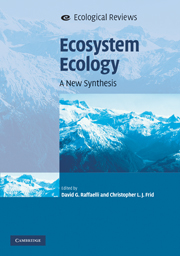Book contents
- Frontmatter
- Contents
- List of contributors
- Preface
- 1 The evolution of ecosystem ecology
- 2 Linking population, community and ecosystem ecology within mainstream ecology
- 3 Thermodynamic approaches to ecosystem behaviour: fundamental principles with case studies from forest succession and management
- 4 Ecosystem health
- 5 Interdisciplinarity in ecosystems research: developing social robustness in environmental science
- 6 The links between biodiversity, ecosystem services and human well-being
- 7 Ecosystem ecology and environmental management
- Index
- References
7 - Ecosystem ecology and environmental management
Published online by Cambridge University Press: 05 June 2012
- Frontmatter
- Contents
- List of contributors
- Preface
- 1 The evolution of ecosystem ecology
- 2 Linking population, community and ecosystem ecology within mainstream ecology
- 3 Thermodynamic approaches to ecosystem behaviour: fundamental principles with case studies from forest succession and management
- 4 Ecosystem health
- 5 Interdisciplinarity in ecosystems research: developing social robustness in environmental science
- 6 The links between biodiversity, ecosystem services and human well-being
- 7 Ecosystem ecology and environmental management
- Index
- References
Summary
Conserving ecosystems and their biodiversity must be a shared objective of industry, the conservation community and consumers. Nowhere is this more important than in agriculture that directly depends on nature. The tight agricultural markets make this even more urgent.
Julia Marton-Lefèvre, IUCN Director General.In the last 40 years, the area of global agricultural land has grown by 10%, but in per capita terms agricultural land area has been in decline. This trend is expected to continue as land is increasingly limited and the population grows.
From WBCSD/IUCN 2008Introduction
With the adoption of the Convention on Biological Diversity (United Nations1992), the sustainable management and protection of biodiversity shifted from being an option to an acknowledged necessity: sustainability is now the high-level goal of environmental management policy. Sustainability implies the ability for processes and activities to be able to continue indefinitely. Within the specific context of environmental management this has been taken to mean meeting the needs of the present without compromising the ability of future generations to meet their own needs (derived from the definition of sustainable development developed by the Brundtland Commission (World Commission on Environment and Development 1987)). More recently the concept has been expanded to explicitly include three elements, sometimes referred to as the three pillars of sustainability: environmental, social and economic (Table 7.1). For many policy makers, sustaining social structures and hence economic systems is the imperative, while many scientists would argue that you cannot have a sustainable economy without sustainable use of natural systems.
- Type
- Chapter
- Information
- Ecosystem EcologyA New Synthesis, pp. 140 - 158Publisher: Cambridge University PressPrint publication year: 2010

